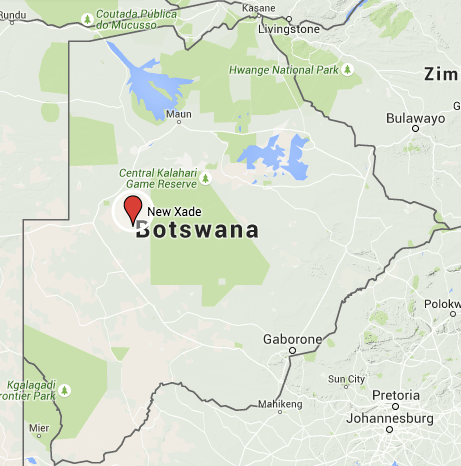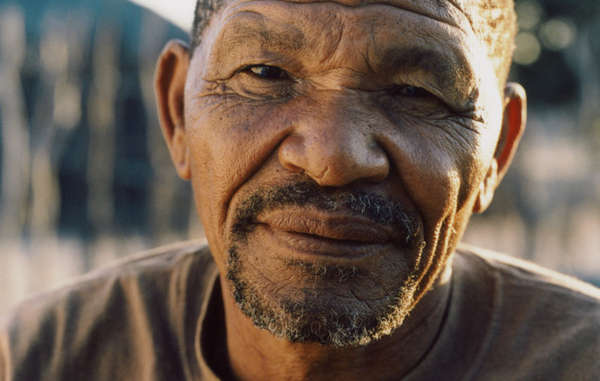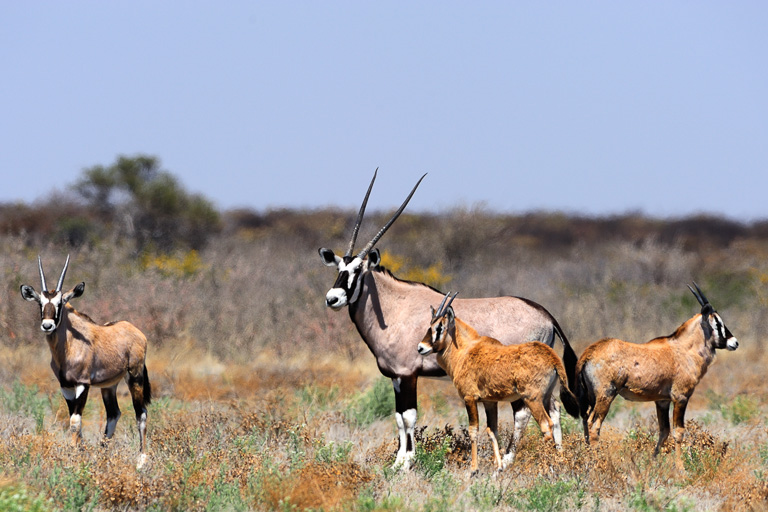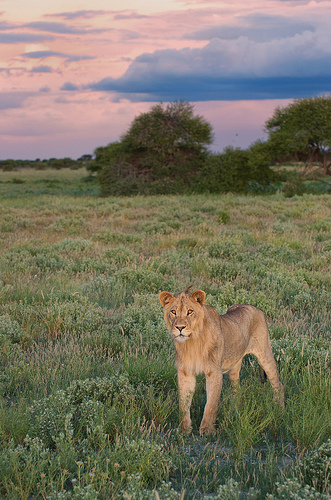- San and Bakgalagadi people have been evicted from Botswana’s Central Kalahari Game Reserve out of concern that the groups’ hunter-gatherer way of life was harming wildlife.
- The groups have been fighting to return for nearly two decades, and are preparing their next legal offensive under the threat of government reprisals.
- They argue that the indigenous groups, making their living on the land with traditional hunting and gathering lifestyles, are far better able to preserve biodiversity than contemporary conservation approaches, such as wildlife-only parks.
In 1997, the government of Botswana began evicting San and Bakgalagadi people from their homelands in the Central Kalahari Game Reserve out of concern that the groups’ hunter-gatherer way of life was harming wildlife. Since then, local and international advocacy groups have been engaged in an arduous struggle to enable the groups to return.
Domestic activists face harsh consequences from the state, including arrest, beating, and alleged torture, while foreign activists on their behalf face arrest, visa restriction, and expulsion from the country.
As the San and Bakgalagadi and their advocates prepare their next legal offensive under the threat of government reprisals, they are raising questions not only about the value of human rights in Botswana, but also about how best to steward the country’s rich natural resources. They argue that the indigenous groups, making their living on the land with traditional hunting and gathering lifestyles, are far better able to preserve biodiversity than contemporary conservation approaches, such as wildlife-only parks.
A place called home
The Central Kalahari Game Reserve (CKGR), a massive wilderness roughly twice the size of Massachusetts, was established in 1961 under the Fauna Conservation Proclamation in what was then the British-controlled Bechuanaland Protectorate.

The reserve was set up prior to Botswana’s political independence in 1966 to ensure that the indigenous San and Bantu Bakgalagadi populous would remain stable after power was ceded to the ruling Tswana ethnic group. The reserve was declared a safe haven where the groups could continue their traditional way of life.
The San, a people comprised of around 35 language groups, have lived in southern Africa since time immemorial. The Bakgalagadi, with roughly five language groups, have lived there for at least 1,500 years.
Both groups’ lifestyles are adapted to the onerous surroundings of the Kalahari — a semi-arid desert susceptible to droughts and temperatures reaching upwards of 113 degrees Fahrenheit. Acquiring food traditionally entails hunting and gathering, though practices have evolved over time to include small-scale farming and pastoralism, in addition to employment as herders, domestic employees, and hunting guides.
From 1966 until the 1980s, the CKGR remained relatively stable for the San and Bakgalagadi living there. But in 1986, the government of Botswana implemented an initiative for what it calls Remote Area Dwellers, ostensibly to improve the livelihoods of rural citizens. Part of the initiative followed recommendations from a study carried out by ecologists and government officials that concluded that the people living in the CKGR were an imminent threat to the fauna, and the government declared that settlements should be relocated outside the reserve. In 1997, the government of Botswana began forcibly evicting the San and Bakgalagadi from the CKGR. Two resettlement camps, New Xade and Kaudwane, were constructed for them outside the reserve’s western and southern borders.

To force them off the land and into the camps, the government terminated basic services in January 2002. They capped manmade water sources known as boreholes and discontinued food rations, school transportation for children, and healthcare assistance. The government banned the groups from hunting in the reserve that same year.
Overall, somewhere between 2,200 and 2,500 people were resettled, though the government claims that many left the reserve of their own volition. In any case, a mélange of welfare dependency, prostitution, and alcohol abuse now dominate people’s daily lives in New Xade and Kaudwane, according to Gordon Bennett, a British human-rights attorney who has worked for the two groups on various proceedings against the Botswana government.
San and Bakgalagadi people contacted for this story declined to speak on record or to detail their encounters with the government, apparently out of fear of reprisal. Bennett offered his account of their current living conditions in New Xade, where he has visited.
“It’s not possible to forage or gather because vegetation doesn’t grow there,” he told mongabay.com. “They don’t find their food anymore. They open a packet delivered to them by the government. It is extremely humiliating to people. It’s the first time for many of them, especially the older people that they’ve had to live like this. Parents have nothing to teach their children, the children are drinking, they’re contracting AIDS, and getting into fights.”
Anyone caught hunting in the CKGR faces severe consequences, Bennet said. “The end result is that the wildlife scouts tend to give people a beating when they catch them because it’s much quicker, it’s much cheaper, and it’s more effective than prosecution. They beat them on the soles of their feet with a stick or they drag them along behind a car for a couple of kilometers,” he said.

Roy Sesana is a San activist and founder of a now-dissolved advocacy group called First People of the Kalahari. In 2005, he and 21 others were arrested and beaten for attempting to bring food and water into the reserve for their families, who were on the verge of starvation. His brother died shortly after receiving a beating from wildlife officers one year earlier.
Following his arrest, Sesana was awarded a Right Livelihood Award by the Swedish parliament. “The president says unless we change we will perish like the dodo. I didn’t know what a dodo was. But I found out: it was a bird which was wiped out by settlers. The president was right. They are killing us by forcing us off our land,” he wrote in his acceptance speech, with help from English-speaking friends.
Sesana has expressed concern that the San culture will soon die out in the limbo of the resettlement camps. “The only place where you find Bushmen now in our traditional clothes surrounded by traditional huts is in the local tourism villages,” he told a BBC reporter for a 2014 news report. “We are worried that in the future, there will be no-one who would be able to practice the Bushman culture unless they are parading in front of tourist for companies who are using them for business,” he said.
Reprisals against foreigners
The first publicly known foreign activists to be removed from Botswana were Mark and Delia Owens, American researchers turned animal-rights advocates who lived and studied wildlife in the CKGR’s Deception Valley for seven years during the mid-1970s. Their 1984 autobiography Cry of the Kalahari described their living conditions and research findings.
Two years after the book came out, in 1986, they were expelled from the country over their criticism of the commercial cattle industry’s impact on the Kalahari ecosystem and calls for better conservation efforts. Years later, the Owenses were also criticized by academics and Kalahari indigenous people’s advocates for having contributed to the expulsion of the San and Bakgalagadi from the reserve by taking part in the government’s ecological surveys — claims the pair has denied.

Since then, dozens of foreign academics, journalists, and human rights activists who reported on or protested the marginalization of the Kalahari people have been issued visa restrictions or declared prohibited immigrants.
Among them were four officers of the indigenous rights advocacy group Survival International who were issued prohibited immigrant status in 2007. The group has had a contentious relationship with the government and it continues to make hardline calls for the restoration of land and hunting rights to the San. “Removing [them] from their ancestral lands opens up the CKGR to fracking exploration, exploitation through tourism, and diamond mining,” Survival International spokeswoman Alice Bayer said in an email to mongabay.com.
Criticism of fracking and diamond mining is a particular sticking point with the government of Botswana. Various groups have alleged that the government expelled the Kalahari peoples specifically to make way for two diamond-mining concessions located within the CKGR. The first mine opened last year and is expected to produce diamonds worth roughly $65 million annually. However, the government and even a San advocacy group have denied that mining contributed to the expulsion, pointing out that the reserve is immense enough to accommodate both mines and people.
Gordon Bennett’s visa application is currently denied. In June 2013 he was working on a case involving another group of San living in a community called Ranyane to the west of the game reserve. The San argued that Ranyane was their ancestral homeland, but they were being threatened with eviction by the local district council. The court ultimately ruled in favor of their right to stay.
Bennett recalled coming out of the courthouse to a number of San in ceremonial dress celebrating the victory. Following their show of appreciation, he briefly told them publicly that they should be thanking one another instead for having successfully utilized the justice system.

“Somebody, I think, was listening,” Bennett said. “Two days later I was effectively arrested. I was taken against my will to the Department of Immigration, where I was interviewed by the permanent secretary. He had questions about the manner in which I filled in my application form when I’d arrived. As I was leaving he said, ‘You are making political speeches. If you do that, you will not be a friend of Botswana.’ I asked him what political speeches he had in mind. He said he wasn’t prepared to tell me. I am not a politician. I do not make speeches.”
Bennett speculated that government actions against outside advocates are partly a reaction to losing in court — the 2013 case was their third loss. “I think that they just got fed up,” he said. “I think that they felt that we are interfering in somebody else’s affairs and, and that although they might take some political flack, it’s a price worth paying because they can keep us out and we won’t be any more trouble.”
Tempered legal victories
The Kalahari people first issued litigation against the government of Botswana over their relocation from the CKGR in 2002. Their initial attempt was dismissed by Botswana’s High Court on a technicality. But the appeal was successful, developing into the longest court case in the country’s history.
Gordon Bennett began representing the groups in 2004 after two years of impediments that he said were due in part to procedural mistakes made by the original legal team. Litigation costs were funded primarily by Survival International.
In December 2006 the High Court granted permission for 189 of 243 applicants to return to the CKGR. They were permitted to hunt and gather, provided they acquired government-approved game licenses. The caveat to the victory was that all social services would remain withheld.
Bennett described the result: “The people faced an obvious difficulty because there was no water source within the reserve. The government had capped off the only borehole and refused to reopen it.”
The Kalahari people then commenced a legal battle over their right to water in the CKGR. They won that case, too, in January 2011. “That really made it feasible for people to return, particularly with elderly dependents or young children, because the lack of water can be very difficult in that environment,” Bennett said.

The people’s return to the reserve held another hidden caveat, according to Bennett, which is that the government refused to issue game licenses, despite the court having declared in 2006 that this was a violation of the groups’ right to life, food rations having been revoked.
Bennett and his team are currently preparing to challenge that order. In the interim, local people either living in or traveling to the CKGR continue hunting despite the risks of a beating or arrest should they be caught.
Conservation complexities
Aside from avoiding the cost of providing remote services to the San and Bakgalagadi, conservation remains the Botswana government’s primary motivation for resettlement. Several government officials did not respond to requests for comment for this story. But officials have stated that removing people was done as a direct response to ecological threats, including overhunting and habitat degradation, according to news reports.
In response to calls for increased wildlife security by various international conservation institutions, the government of Botswana has been boosting ecotourism and now roughly 12 percent of the country’s GDP falls under the ecotourism umbrella.
Largely seen as a win-win scenario by many environmentalists, ecotourism provisions wilderness and wildlife security in exchange for hefty tourist spending— primarily from foreigners keen to view Africa’s storied fauna in unspoiled environments. Part of the reason for keeping the San and Bagkalagadi out of the CKGR is that the Botswana government fears that foreign ecotourists won’t like seeing people in the reserve, both because the wilderness won’t look “natural,” and also because they are embarrassed by the groups’ “primitive” appearance, according to an activist on behalf of the displaced groups who requested anonymity due to concerns of possible government reprisal.

But despite the apparent success of ecotourism in many places, there are critics who question whether it is the only viable option in Africa to provide livelihoods for locals when regulated subsistence hunting is outlawed.
“I think [ecotourism] can be worse because you have to have a lot of infrastructure for tourists who certainly don’t want to be uncomfortable. That pressure invariably results in habitat degradation, and further, it destroys the traditional culture that has sustained that game for so long,” Glen Martin, a freelance journalist and author of the 2012 book Game Changer: Animal Rights and the Fate of Africa’s Wildlife, told mongabay.com.
Having spent time with the Ju/’hoansi San in Namibia’s Nyae Nyae Conservancy, Martin described what their inclusion in the reserve has meant: “For them, it’s a lot simpler than people think. All they want to do is continue being a highly conservative traditional people, which means hunting. They don’t ask for infrastructure. They don’t really ask for anything. They just want to be able to hunt, which transcends our notion of hunting and what it means. That needs to be accommodated. If it is, you’re going to see a better outcome.”
Ironically, bans on regulated hunting by traditional people may lead to rapid wildlife population reduction as poachers move in and exterminate unsustainably. In his book, Martin describes the conservation model in Kenya, which outlawed game hunting in 1977. Since then, 60 to 70 percent of the country’s wildlife has been lost, primarily to poaching and alternative development schemes like commercial agriculture.
“Unless you instill some value to the game for local people, they’re going to kill it all,” Martin explained. “They are always on the cusp of survival. Unless there’s some sort of utilitarian benefit to them, they’ll destroy it and either raise goats or make charcoal instead, because to a certain degree they have no real choice.”
In contrast to Kenya and Botswana, Namibia encourages a more community-based conservation approach, with rigorously managed subsistence hunting as an accompaniment to ecotourism. The result is stabilized wildlife numbers and stronger conservation support from rural communities.
In contrast to the trending environmental philosophy of fauna preservation at any cost, this approach holds that having a local population that kills what it needs to survive actually stabilizes, and may even help bolster wildlife populations.
Namibia’s Nyae Nyae Conservancy is just one of many examples where local people — in this case the Ju/’hoansi — are allowed to hunt, and relied on to report incidents of illegal poaching to game management authorities.

“These guys are almost supernatural trackers and hunters,” said Martin. “When they’re out there, they know where every animal is, they know if anyone comes in, and they know if something is taken illegally. You couldn’t have a better system for conservation.”
But the reverse appears to be far more common. Around the world, indigenous “conservation refugees” pushed out of their homelands to make way for wildlife parks number in the millions, according to a 2014 report by Survival International. The group heaps criticism on major international NGOs for turning a blind eye to human rights violations made in the name of conservation and the preservation of wilderness.
The future
Conservation aside, Botswana hopes to continue progressing economically and socially. Many Botswanan people, including the government, view hunting and gathering lifestyles as archaic indicators of poverty. Moreover, having witnessed South Africa’s disastrous attempt to keep races separate under Apartheid, the government is making a strong push for social equality and does not want its citizens treated differently or preferentially.
Gordon Bennett sympathizes with the government’s predicament, but only to a point. “They think that if people like me get my way, then they will have to keep the [San and Bakgalagadi] separate. But I say no, not at all. If they want to join mainstream society, then that’s absolutely fine. But if they don’t then they should have the right to decide to go their own way.”

The future of the San and the Bakgalagadi hangs in the balance. Despite Bennett’s visa setback, he and his team are now preparing for two related cases. The first is aimed at forcing the government to issue hunting licenses to San and Bagkalagadi people now living in the reserve. The second, more tedious case involves gaining access to the CKGR for the people who remain barred from returning.
For the time being, the Central Kalahari Game Reserve remains a magnificent wilderness where people from all corners of the globe can travel — all except those who call it home.
Citations
- Fihlani, P. (2014). Botswana Bushmen: Modern life is destroying us. BBC News.
- Goldberg, J. (2010). The hunted. The New Yorker.
- Martin, G. (2012). Game Changer: Animal Rights and the Fate of Africa’s Wildlife. University of California Press.
- Ontebetse, K. (2013). Botswana slaps visa restrictions on Malema, Bennett. Sunday Standard.
- Owens, M., & Owens, C. (1984). Cry of the Kalahari. Mariner Books.
- Sarkin, J., & Cook, A. (2010-2011). The Human Rights of the San (Bushmen) and of Botswana – the Clash of the Rights of Indigenous Communities and their Access to Water with the Rights of the State to Environmental Conservation and Mineral Resource Exploitation. Journal of Transnational Law and Policy 20:1-40.
- Parks Need Peoples (2014). Survival International. London, UK.